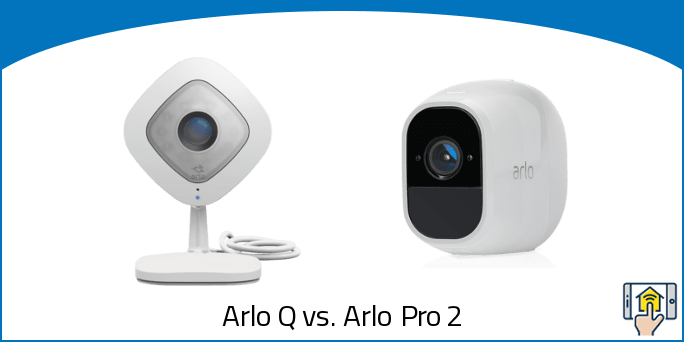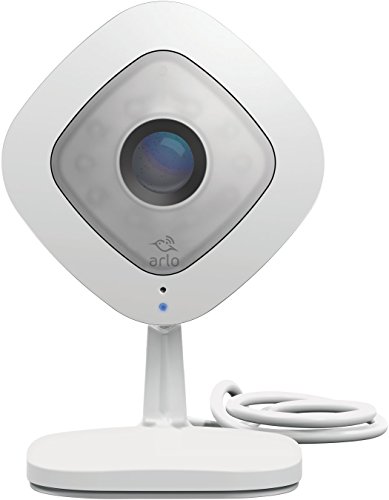Arlo has produced some seriously impressive camera solutions, and their product lineup continues to expand with bigger and better options for home video monitoring. The Arlo Q and Arlo Pro 2 are both excellent cameras in their own right, and it’s difficult to give a clear answer as to which one is the best overall. If you’re looking for an outdoor camera, there’s no doubt that the Arlo Pro 2 is your best bet, while the Arlo Q provides quality indoor monitoring without the need for a base station.
There are a lot of aspects that these two cameras have in common, but there are actually a significant number of differences too. Perhaps the most notable change when comparing the two devices is that the Arlo Pro 2 requires a base station to function. This is a little inconvenient and is an extra expense, but it also enables a number of features that are straight-up absent on the Arlo Q. With that said, the Arlo Q still pulls ahead in certain areas like dual-band WiFi and better motion detection.
Ultimately, the best choice is going to depend on what you’re looking for in a smart camera. Below we go into detail on the similarities and differences of the Arlo Q vs. Arlo Pro 2 to help make the decision a little easier, but feel free to use our navigation bar to jump directly to the sections you care about most.
Arlo Q vs. Arlo Pro 2 — Things in Common
-
Video Quality – One of the most important parts of any camera is the actual video quality, since all the features in the world won’t really matter if you have a blurry picture. Fortunately, both the Arlo Q and Arlo Pro 2 share the same high-end specs with a 1080p HD resolution, 30 FPS, a 130 degree field of view, and H.264 video formatting that compresses the stream to allow most any home network to host three or four cameras without any network strain.
-
Live View – Both models allow you to check in on your cameras with a live view whenever you please, and also offer recording free of charge. Arlo is one of the rare camera brands that allows you to access pretty much all aspects of the camera’s general functions without paying any extra (although recorded storage is somewhat limited without a subscription).
-
Zoom – Zoom in on the action and take in all the details with 8x digital zoom.
-
Two-Way Audio – A mic and speaker are built into both the Arlo Q and Arlo Pro 2 camera, which is mighty convenient for checking in on your pets (although a camera like the Petcube or Furbo might be better suited for that), but it’s also a great security feature as well. Being able to yell at trespassers can keep your nosy neighbor from swiping your packages — or even prevent a home invasion. It’s not a feature you’ll find yourself using every day, but it’s great to have it there when you need it.
-
Night Vision – The Arlo Q and Arlo Pro 2 both feature 850 nm LEDs that can illuminate up to 25 feet, which should provide adequate visibility during the night. Both cameras are also equipped with an infrared cut-off filter that makes for a better quality picture in low light conditions.
-
Subscription & Cloud Storage – Both cameras work off of the same subscription model. Since live video view and recording are available free of charge, the Arlo Smart subscription is completely optional, but it does add some extra functionality and more support for a larger lineup of cameras.
By default, your Arlo camera includes 7 days of cloud recording, and your account will be able to support up to 5 different cameras. If you’d like longer storage of video footage or to expand your lineup with extra equipment, you’ll have your choice of several different options: Arlo Smart Add-on, Arlo Smart Premier, and Arlo Smart Elite.
First, let’s talk about Arlo Smart Add-on. This tier includes all of the features available from the subscription model, but is charged at $2.99 per camera. It’s the perfect option for homeowners with just one or two cameras, since it’s a low monthly fee and gives you access to everything the brand has to offer.
Speaking of features, Arlo Smart Add-on includes person detection that will give you an instant alert when human activity is detected, as well as cloud activity zones that allow you to limit motion detection to areas that you choose — an especially useful perk for outdoor cameras monitoring areas next to a busy pathway or street.
The subscription also enhances your video equipment with extra security features, such as Rich Notifications that will allow you to respond to an alert simply by tapping or swiping to sound an alarm or call emergency services — all without having to unlock your device or enter the app. E911 Emergency Call Service rounds out Arlo Smart’s features with the ability to send first responders directly to your home rather than tracking your phone when you could be miles away from a crisis.
That ~$3 per month subscription adds in a bunch of extra features, but to increase your allowance for video recording or add in more than 5 cameras, you’ll need to pay for a higher tier plan. Arlo Smart Premier at $9.99 per month supports 30 days of recordings and 10 arlo cameras, and Arlo Smart Elite at $14.99 per month supports 60 days of recordings and up to 20 arlo cameras. Both of these plans also include everything you get from the $2.99 add-on as well.
-
App Support – Access your smart cameras from wherever you happen to be using the Android, iOS, or Web apps. The Web support is especially nice, as it allows you access from your laptop or desktop rather than limiting control of your cameras to smartphones.
-
Voice Control – The Arlo Q and Arlo Pro 2 both feature Voice Control with Amazon Alexa, and you can use the Echo Show or Echo Spot to check your video feed on the cameras as well. Just note that you won’t be able to use the two-way audio feature through the Echo Show, with the utility limited to voice control and viewing the feed in that instance.
For fans of Google Home, you’ll be happy to hear that both cameras work quite well with Google Assistant too.
-
IFTTT & Stringify – last but not least, we’d like to mention the great integration that both Arlo Q and Arlo Pro 2 have with IFTTT and Stringify. These two trigger systems are a large part of the “brains” behind the smart home of your dreams. By tying different products together, you can create a web of technology that responds automatically to meet your needs — and Arlo equipment can fit quite nicely into that. From something as simple as flashing lights when motion is detected, to adjusting your home’s temperature when the Arlo sensors detect movement, the sky’s the limit when it comes to IFTTT and Stringify.
Arlo Q vs. Arlo Pro 2 — Differences
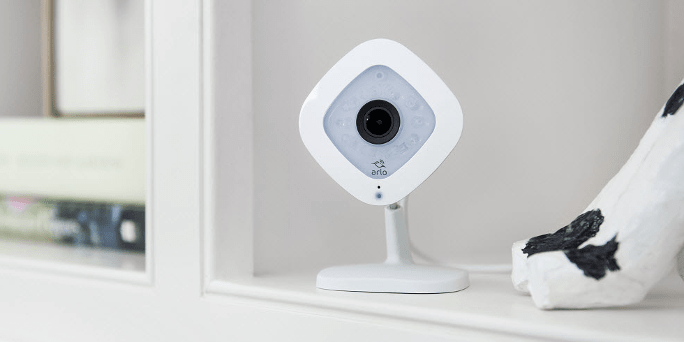
-
Difference #1: WiFi – The first points to discuss when comparing Arlo Q vs. Arlo Pro 2 are the differences in their WiFi support. Arlo Q is a dual band 2.4 & 5GHz system, which means it can take advantage of both of these wireless frequencies to prevent putting a lot of stress on your network.
Arlo Pro 2 only supports 2.4GHz connections. This shouldn’t be a problem with a small amount of cameras, but on a slower network with 15 different Arlo cameras, you may start to notice some bandwidth issues.
-
Difference #2: Power Options – When it comes to power options, there’s no denying that the Arlo Pro 2 gives you more flexibility.
Arlo Q can only be powered using an AC Plug. The Pro 2, on the other hand, can run off a rechargeable battery in addition to AC. When you add in optional solar charging, you can essentially have a device that generates its own power and that can be installed pretty much wherever you please. If you don’t purchase the solar panel, you’ll have to charge the battery every 3-6 months.
We feel that the Arlo Pro 2 definitely has the edge in this section, since it gives you a choice between traditional AC power and the flexibility of battery-powered operation. With that said, one of our favorite Arlo cameras right now is the Arlo Q Plus which offers Power Over Ethernet charging. Being able to provide a strong and reliable internet signal and steady power through one cord is really just too good to pass up! Check out our comparison of Arlo Q vs. Arlo Q Plus for more details.
-
Difference #3: Motion Detection – One area where the Arlo Q has a significant edge when compared to the Arlo Pro 2 is in the range of its motion detection. Ironically, the Arlo Pro 2 has just 23 feet of motion detection despite its ability to work well outdoors, while the Arlo Q has 50 feet of detection that will largely be wasted in most homes. Regardless, the additional range of the Arlo Q is definitely an advantage and highlights an area where the Arlo Pro 2 (literally) falls short.
Provided that your Arlo camera is plugged in, you’ll also be able to designate up to 3 activity zones to target motion detection on the areas where you need extra security while avoiding false alarms in heavily trafficked areas.
Both cameras do feature person detection, but you’ll need the Arlo Smart subscription to enable that functionality.
-
Difference #4: 24/7 Recording – Both cameras are primarily designed to record when motion is detected and simply provide a live video feed at all other times. However, Arlo Q and Arlo Pro 2 both offer the option for CVR (continuous video recording) as well for an additional cost.
For 14 days of storage, you’ll be paying $9.99 per month per camera, and 30 days brings the price up to $19.99. It’s relatively expensive and probably isn’t feasible for more than a camera or two, but it’s nice to have the option there if you’re interested in having non-stop footage of a particularly vulnerable area.
Keep in mind, too, that this option is only available with the Arlo Pro 2 if it’s plugged in since CVR requires a lot of power. Unfortunately, this means 24/7 recording isn’t a possibility for homeowners who were hoping to use the battery or solar power to run their cameras.
-
Difference #5: Requires a Base Station – One of the biggest differences between these two cameras is a piece of equipment called the “base station.” The Arlo Q will function as-is, right out of the box with no additional setup. The Arlo Pro 2 needs the Arlo Pro Base Station to function, which is an additional expense you’ll have to consider when comparing products.
The base station may seem like a major disadvantage, and in a way, it is. However, being able to take advantage of that base station allows the Arlo Pro 2 to use some extra features that aren’t included on the Arlo Q. For example, you’ll have additional range and better battery life with your cameras, as well as access to options like local backup storage and a siren in the base itself.
Ultimately, despite these extra features, we still feel like the base station is more of a hindrance than it is an enhancer. Being able to just pick up the Arlo Q and get started without any additional purchases wins it major perks in our books.
-
Difference #6: Local Backup Storage – Since the Arlo Pro 2 requires the base station, you’ll be able to take advantage of local backup storage. While this can’t serve as a substitute for cloud storage, it’s useful to have in the event of an outage since your storage will still be stored locally. The Arlo app will inform you when your USB storage is starting to get full, and can even start recording over older footage automatically if it runs out of space.
The Arlo Q doesn’t use the Arlo Base Station, and thus, doesn’t have any access to local backup storage. We will say, however, that the slightly-upgraded Arlo Q Plus has local storage on an SD camera right on the camera itself, so that’s always an option if you’re looking for the features that the Q has to offer with a couple of extra perks.
-
Difference #7: Siren – A major disadvantage to the Arlo Q is that it doesn’t have any support for sirens whatsoever. The Arlo Pro 2 has a siren built into the base station that it can activate in the event of an emergency, which is very important when it comes to keeping your home and family protected. The fact that the Arlo Q omits this feature really holds it back from a security standpoint. You’ll be able to recognize when there’s a problem, but you’ll be left on your own to alert your family or call the authorities.
-
Difference #8: Weather-Resistant – Last but not least, the Arlo Pro 2 is weather resistant with IP65 rating, so you can use it indoors or outside.
The Arlo Q is only suited for use inside, which makes it a hard pass for anyone looking to monitor the exterior of their home.
Arlo Q vs. Arlo Pro 2 — Comparison Chart
| Arlo Q | Arlo Pro 2 | |
|---|---|---|
| Video resolution | 1080p HD | 1080p HD |
| Frames per Second | 30 FPS | 30 FPS |
| Video Format | H.264 | H.264 |
| On-Demand Live View | Yes | Yes |
| Record Live View | Yes | Yes |
| Field of View | 130° | 130° |
| Zoom | 8x digital zoom | 8x digital zoom |
| Power | AC | Rechargeable Battery/AC |
| Optional Power Source | No | Solar Panel |
| Battery Life | N/A | Battery: 3-6 months Solar: indefinitely |
| Two-Way Audio | Yes | Yes |
| Motion Detection | Up to 50 feet | Up to 23 feet |
| Motion Zones | Up to 3 activity zones | Up to 3 activity zones when plugged-in |
| Person Detection | With Subscription | With Subscription |
| Facial Recognition | No | No |
| Sound Detection | Yes | Yes |
| Night Vision | 850 nm LEDs: illuminates up to 25 feet IR cut-off filter |
850 nm LEDs: illuminates up to 25 feet IR cut-off filter |
| WiFi | 2.4 & 5GHz | 2.4GHz |
| Requires a Base Station | No | Yes |
| Max # of Cameras per Base Station | – | 15 |
| Siren | No | Via the Base |
| 24/7 Recording | Optional | Optional when plugged-in |
| Local Backup Storage | No | Via the Base |
| Cloud Storage | 7-Day Free / Subscription | 7-Day Free / Subscription |
| Review, Share, & Save | Yes | Yes |
| e911 Emergency Call | With Subscription | With Subscription |
| Instant App Alerts | Yes | Yes |
| App Support | Android, iOS, Web | Android, iOS, Web |
| Rich Notifications | With Subscription | With Subscription |
| Weather-resistant | No | IP65 rating |
| Amazon Alexa | Echo Show, Echo Spot | Echo Show, Echo Spot |
| Google Assistant | Yes | Yes |
| IFTTT | Yes | Yes |
| Stringify | Yes | Yes |
| Operating Temperature | Indoors | -4° to 113° F |
| Dimension | 2.75 x 2.80 x 4.50 in | 3.1 x 1.9 x 2.8 in |
| Color | White | White |
Arlo Q vs. Arlo Pro 2 — Accessories
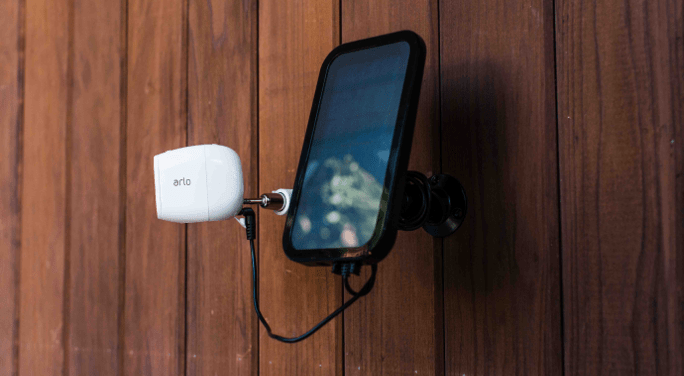
The Arlo Q functions quite well as is, and there isn’t really anything you could add to the existing setup. Since there’s no base station or alternative power options, it’s basically as simple as plugging it into power and then accessing the settings through the Arlo App.
The Arlo Pro 2, on the other hand, does have some useful accessories we’d like to recommend. If you do decide to power your camera using the battery, you might want to invest in a Solar Panel so you won’t have to charge it every few months. If you’d prefer to skip the panels, you could also just purchase an extra rechargeable battery so you can easily swap a depleted one out for one that’s full — minimizing downtime spent charging. The Arlo Security Light and Arlo Pro 2 Skins are also great to have to illuminate your yard when motion is detected and keep your cameras disguised from intruders.
Arlo Q vs. Arlo Pro 2 — Our Thoughts
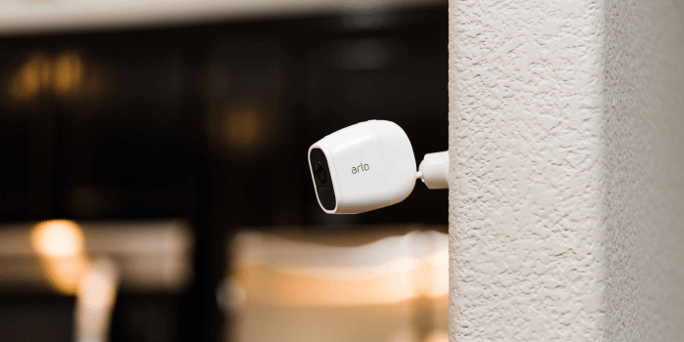
All in all, determining the top dog when comparing the Arlo Pro 2 vs. Arlo Q isn’t exactly an easy task. Unlike some other brands with a very obvious upgrade from one model to the next, there are areas where these two models excel and where they far short.
Ultimately, we’re inclined to recommend the Arlo Pro 2 due to the greater flexibility with installation, including the ability to run off of battery power and to install outside. Another huge advantage is the inclusion of a siren, which is notably absent on the Arlo Q. The biggest downside to this specific camera is that it requires a base station to function, which adds more clutter around your router and extra expense. The local storage, increased range, and better battery power aren’t quite enough to make us excited about having another “smart hub” to deal with.
The Arlo Q has a lot going for it, and we love that you can just take it out of the box and get your video monitoring up and running in just a few minutes. The fact that you need to plug it in and can’t use it outdoors makes it a little bit more of a specialized indoor camera, however, so it’s difficult to recommend it as a clear winner.
The best way to break things down is probably that the Arlo Pro 2 is a better all-around choice, while the Arlo Q is an excellent “plug and play” option for indoor monitoring with some upgraded perks like dual-band WiFi and better motion detection.
Last update on 2024-04-23 at 19:16 / Affiliate links / Images from Amazon Product Advertising API
